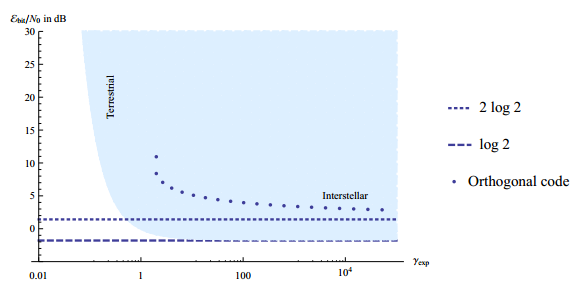How to Design an Interstellar Communications System
Here’s an interesting question. If we ever want to communicate with civilisations around other stars, what will be the best way to send a message, given that we will know nothing about how they intend to receive it?

That’s the question considered today by David Messerschmitt at the University of California, Berkeley. It turns out that the laws of physics, the nature of interstellar space and a little common sense place surprisingly strict bounds on how communication can take place. So if extraterrestrials think in a way that is anything like us, communication of one kind or another is distinctly possible.
Messerschmitt begins by listing the way in which any form of communication is likely to be limited. To begin with, he says that the power of any signal falls with the square of the distance traveled. Assuming that energy is likely to be a limiting factor for a civilisation, an important property of any interstellar transmitter will be to minimise the energy per bit in any signal–while still allowing the reliable extraction of the information it contains, of course.
It’s possible that this civilisation could have found a way to generate energy very cheaply. But even if energy is more plentiful, there are many ways to consume more energy other than deliberate inefficiency, says Messerschmitt. “They could increase message length, reduce the message transmission time, transmit in more directions simultaneously, or transmit a signal that can be received at greater distances.”
Another important design requirement will be to overcome any problems associated with transmitting signals through the interstellar medium. Specifically, certain wavelengths tend to be absorbed while others travel without hindrance. For example, the interstellar medium is essentially transparent to large parts of the microwave spectrum.
In addition to this, says Messerschmitt, a good idea is to exploit the laws of physics and in particular Shannon’s mathematical theory of communication, which determines how much information can be sent to a noisy channel the certain power level. stop
Finally, common sense dictates that we should keep things simple. The more complex the mode of transmission, the less likely it is that it will match the receiver. Keeping things simple seems the best way to ensure the greatest likelihood of success.
This version of Occam’s razor also suggests that there is no reason to send narrow bandwidth signals since these require more energy and greater complexity to transmit. Instead the simplest approach is to send broadband signals, preferably in the microwave part of the spectrum. “It is unlikely that a civilization would use more energy than necessary unless for some reason they consider a reduction in bandwidth to be a higher priority,” says Messerschmitt.
So that narrows down the huge number of potential signals that we could transmit or that we should look out for, to just a few. Provided, of course, that this other civilisation will be thinking in the way that seems obvious to us.
One potential shortcoming is that the science and technologies that Messerschmitt invokes were all developed on Earth within the last century. That’s a blink of an eye in cosmological terms.
Back in the 1970s, the American astronomer Carl Sagan pointed out that any alien civilisation is likely to be at a very different stage in its evolution. Should it be less mature than us, however, this civilisation will not have developed radio technology in the first place.
That means that our potential contacts are likely to be much more advanced, probably centuries or millennia ahead of us. Sagan asked whether it is possible that these civilisations will have stumbled across a better form of interstellar communication technology, one that seems like magic to us.
That’s a hard question to answer. But if so, then our attempts to contact them with microwaves may fall on deaf ears, regardless of how well designed our transmitters and receivers are.
Ref: arxiv.org/abs/1402.1215: Design For Minimum Energy In Starship And Interstellar Communication
Keep Reading
Most Popular
Large language models can do jaw-dropping things. But nobody knows exactly why.
And that's a problem. Figuring it out is one of the biggest scientific puzzles of our time and a crucial step towards controlling more powerful future models.
How scientists traced a mysterious covid case back to six toilets
When wastewater surveillance turns into a hunt for a single infected individual, the ethics get tricky.
The problem with plug-in hybrids? Their drivers.
Plug-in hybrids are often sold as a transition to EVs, but new data from Europe shows we’re still underestimating the emissions they produce.
Stay connected
Get the latest updates from
MIT Technology Review
Discover special offers, top stories, upcoming events, and more.